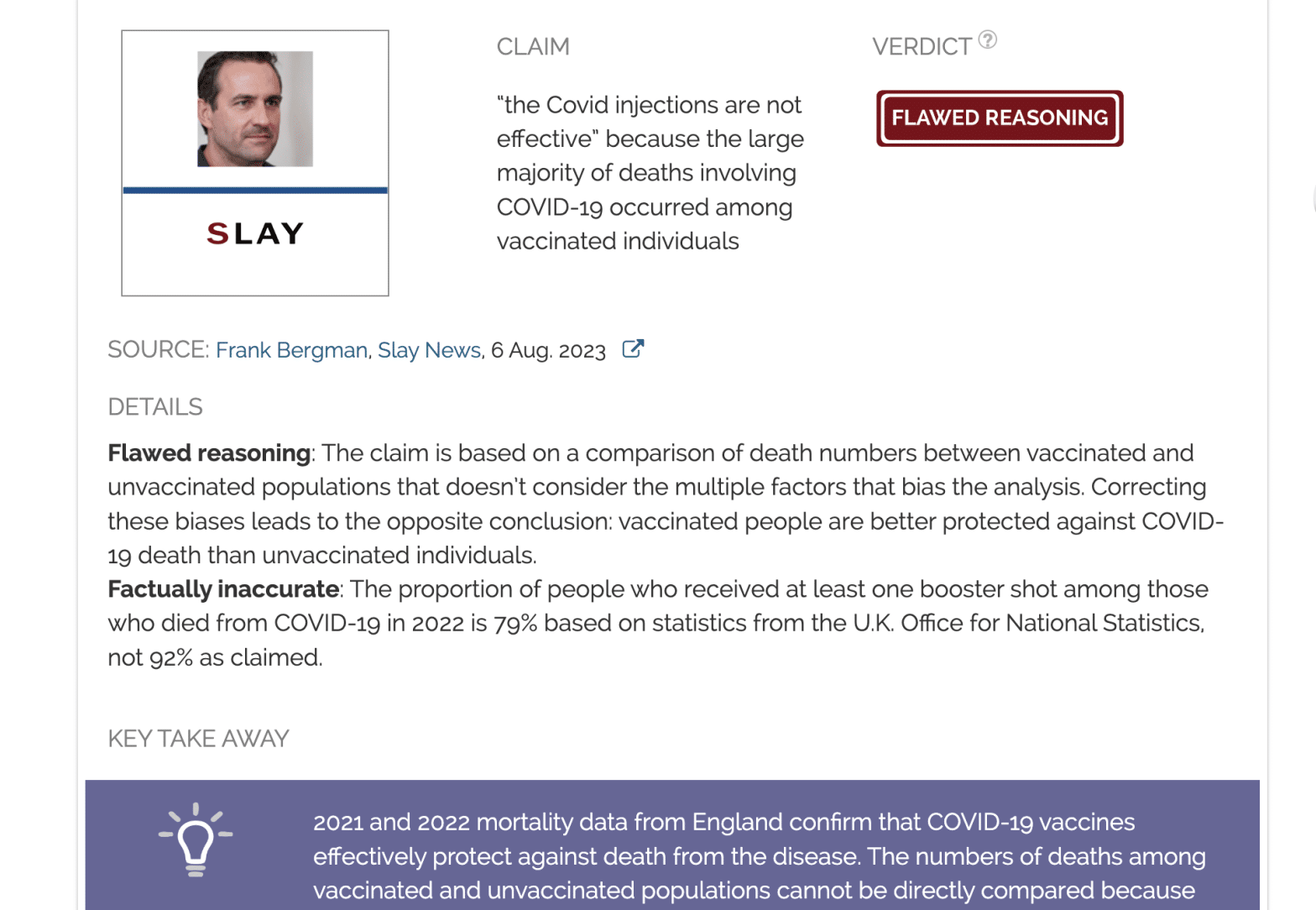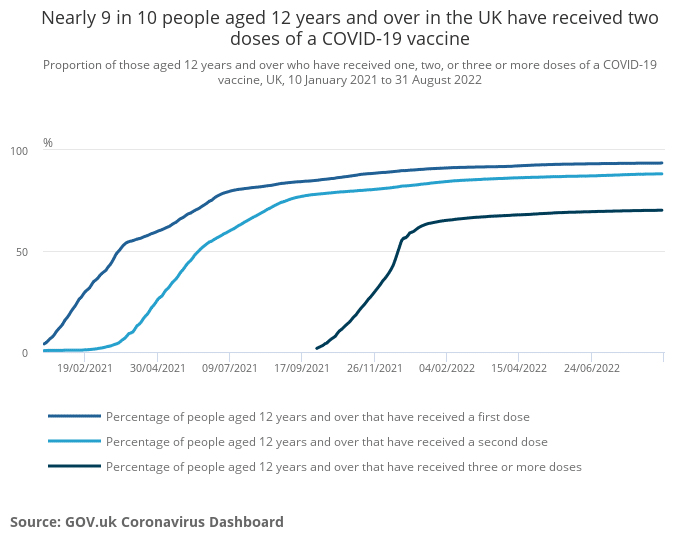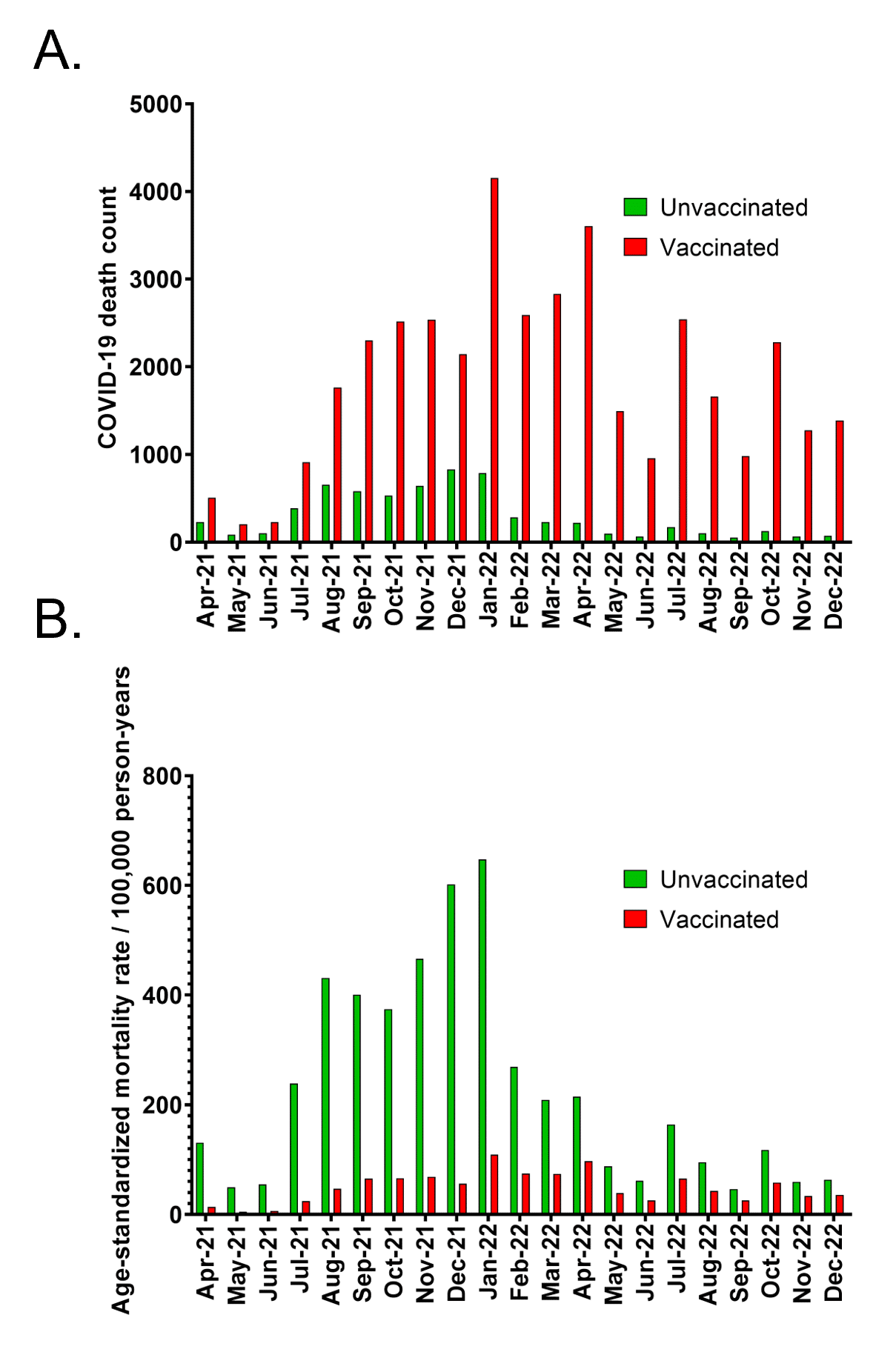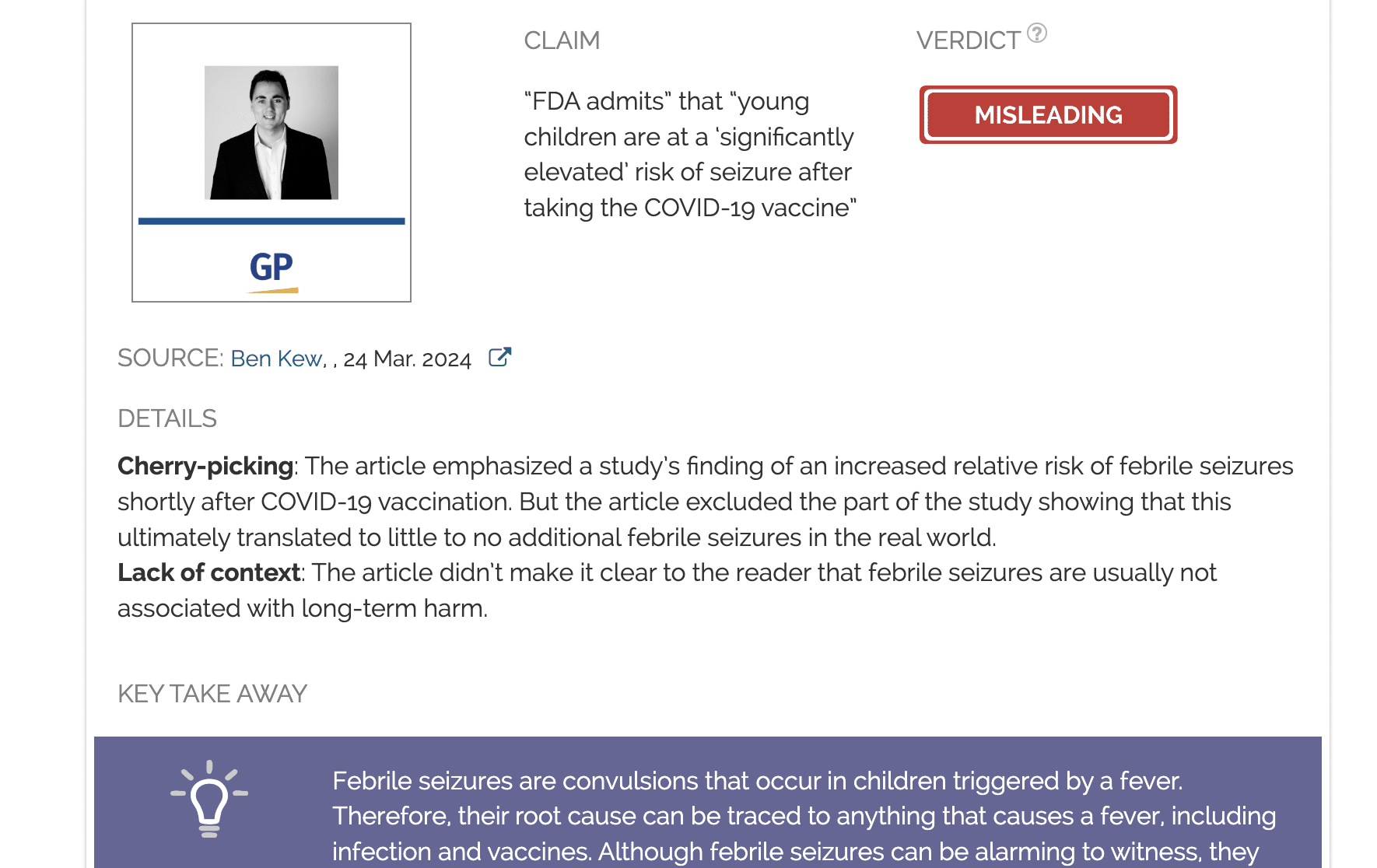- Health
England mortality data shows a lower COVID-19 mortality risk among vaccinated people compared to unvaccinated ones, contrary to claim by Slay News
Key takeaway
2021 and 2022 mortality data from England confirm that COVID-19 vaccines effectively protect against death from the disease. The numbers of deaths among vaccinated and unvaccinated populations cannot be directly compared because of several statistical biases, such as the obvious fact that more people are vaccinated than not. Rigorous analysis accounting for these biases show that the risk of dying from COVID-19 is lower when people are vaccinated.
Reviewed content

Verdict:
Claim:
“the Covid injections are not effective” because the large majority of deaths involving COVID-19 occurred among vaccinated individuals
Verdict detail
Flawed reasoning: The claim is based on a comparison of death numbers between vaccinated and unvaccinated populations that doesn’t consider the multiple factors that bias the analysis. Correcting these biases leads to the opposite conclusion: vaccinated people are better protected against COVID-19 death than unvaccinated individuals.
Factually inaccurate: The proportion of people who received at least one booster shot among those who died from COVID-19 in 2022 is 79% based on statistics from the U.K. Office for National Statistics, not 92% as claimed.
Full Claim
“the Covid injections are not effective” because the large majority of deaths involving COVID-19 occurred among vaccinated individuals; “92% of Covid Deaths in 2022 Were Triple+ Vaxxed”
Review
Large clinical trials and post-marketing real-world data showed that COVID-19 vaccines are effective at preventing severe forms of the disease[1-5]. Despite this evidence, there have been misleading claims that the higher number of COVID-19 deaths among vaccinated individuals compared to unvaccinated ones is a sign that vaccines were ineffective or even counterproductive. Health Feedback reviewed several of these claims in the past and explained why direct comparisons of death counts are misleading.
Along the same line, an article published in Slay News in August 2023 claimed that official data from the U.K. Office for National Statistics (ONS) showed that “92% of Covid Deaths in 2022 Were Triple+ Vaxxed”. It also claimed that “the Covid injections are not effective” because the large majority of COVID-19 deaths occurred among vaccinated individuals.
Slay News has previously made incorrect claims about the COVID-19 vaccines that were reviewed by Health Feedback. In addition, Media Bias/Fact Check has deemed Slay News to have very low factual accuracy.
The recent claim is based on numbers released by the ONS on 21 February 2023 about deaths in England by vaccination status. This dataset showed that people who received at least one dose of a COVID-19 vaccine represented the majority of COVID-19 deaths in 2021 and that this proportion increased further in 2022. However, Slay News’ interpretation that this illustrated the vaccines’ lack of effectiveness is erroneous as it suffers from the same bias that Health Feedback repeatedly warned against in the past.
Simply comparing the number of COVID-19 deaths between vaccinated and unvaccinated groups is a flawed approach
Health Feedback already explained that a direct comparison of death counts between vaccinated and unvaccinated individuals is subject to many biases. One cannot draw meaningful conclusions without correcting them. At least three aspects must be considered: the age difference between populations, the population size difference, and the time spent by individuals in each vaccination category.
First, the vaccinated and unvaccinated populations are made of people of different ages because vaccination prioritized older people, who were more vulnerable to COVID-19. The second figure of this ONS methodology page illustrates how the age structure of the vaccinated and unvaccinated population is different and changed over time. Because the risk of dying from COVID-19 is influenced by the age of the patient, the age difference between the vaccinated and unvaccinated population must be taken into account.
Second, no protective measure is 100% effective. So, some COVID-19 deaths will always occur in both vaccinated and unvaccinated populations. We also know that vaccinated people make up the majority of the population in the U.K., rising from 54% of people above 12 years in April 2021 to 94% in August 2022 (Figure 1). If one population is much larger than the other, it is expected that more deaths will occur in the former, even if the individual risk of dying is lower in that population. We explained this mathematical phenomenon in greater detail here. Thus, it is necessary to ensure that we compare the proportion of COVID-19 deaths in each group, as opposed to the absolute number of COVID-19 deaths.

Figure 1 – Proportion of vaccinated individuals in the U.K population over time. (source: the ONS)
Third, people got vaccinated at different times, so they spent different amounts of time in the unvaccinated and vaccinated categories. A person who got vaccinated in May 2021 will spend most of the April 2021 to December 2022 period in the vaccinated group. Should this person get COVID-19 and die from it, there’s a higher chance that this occurs while being vaccinated. This doesn’t mean that the vaccine doesn’t work, but simply that the person spent more time being potentially exposed to COVID-19 while being vaccinated than unvaccinated. The opposite reasoning would apply to someone who only got vaccinated in November 2022 and spent much of the time period in the unvaccinated category. Thus, how much time each person contributes to each category—vaccinated and unvaccinated— must be accounted for.
The ONS did consider these three risks of bias. Along with the raw death counts, the ONS also reported the age-standardized mortality. As the name indicates, age standardization normalizes the age difference between the unvaccinated and vaccinated population.
Furthermore, the ONS expressed its age-standardized mortality as the number of deaths per 100,000 person-years. A person-year represents the sum of time each person spent in the unvaccinated or vaccinated category. Therefore, this metric accounts for the size of each population and the time spent by individuals in each population.
Figure 2 below illustrates how correcting for the factors mentioned above is crucial. Figure 2A represents the raw number of deaths per month. It shows indeed that there were more COVID-19 deaths among vaccinated individuals. This is what Slay News analyzed and used as the basis for its claim. However, we know now that this metric isn’t appropriate to draw conclusions about vaccine effectiveness because of its many biases.
A better way to compare mortality is thus to use the age-standardized mortality rate provided by the ONS, which corrects the biases mentioned earlier (Figure 1B). Looking at Figure 1B, it becomes clear that the mortality rate is actually much lower among vaccinated individuals. In other words, vaccinated individuals are at a lower risk of dying from COVID-19 than unvaccinated people.

Figure 2 – COVID-19 mortality from April 2021 to December 2022 in England. A. Number of COVID-19 deaths among unvaccinated people or people who received at least one dose of COVID-19 vaccine. B. Age-standardized COVID-19 mortality rate among unvaccinated people and people who received at least one dose of COVID-19 vaccine. The mortality rate is expressed per 100,000 person-years, as provided by the ONS.
People who received booster shots aren’t making up 92% of the deaths from COVID-19
The claim that people who received their vaccine primary series and at least one booster shot—the so-called “triple+ vaxxed”—made up 92% of COVID-19 deaths is factually inaccurate. The ONS figures show that it is actually 79%.
The ONS dataset lists all deaths that occurred in England each month from April 20212 to December 2022, categorized by cause—involving COVID-19 or not—and by vaccination status of the deceased. Therefore, it is possible to extract from the dataset the number of COVID-19 deaths in 2022 among people who received at least one booster shot—that’s 22,242— and the total number of COVID-19 deaths, regardless of the vaccination status—28,041. Thus, deaths among triple vaccinated individuals represented 79% of the total number of COVID-19 deaths (22,242 out of 28,041) and not 92%.
Conclusion
Simple numerical comparisons of death counts can be misleading due to multiple biases in the data. By failing to account for these biases, Slay News provided a flawed analysis of England’s COVID-19 mortality data and drew an ill-founded conclusion. By contrast, the U.K. Office for National Statistics performed an analysis that accounted for several biases, including age differences and population size. This showed that the risk of death from COVID-19 is lower among vaccinated people.
REFERENCES
- 1 – Huiberts et al. (2023) Vaccine effectiveness of primary and booster COVID-19 vaccinations against SARS-CoV-2 infection in the Netherlands from July 12, 2021 to June 6, 2022: A prospective cohort study. International Journal of Infectious Diseases.
- 2 – Andrews et al. (2022) Duration of Protection against Mild and Severe Disease by Covid-19 Vaccines. The New England Journal of Medicine.
- 3 – Link-Gelles et al. (2023) Estimation of COVID-19 mRNA Vaccine Effectiveness and COVID-19 Illness and Severity by Vaccination Status During Omicron BA.4 and BA.5 Sublineage Periods. JAMA Network Open.
- 4 – Solante et al. (2023) Expert review of global real-world data on COVID-19 vaccine booster effectiveness and safety during the omicron-dominant phase of the pandemic. Experts review vaccines.
- 5 – Brito dos Santos et al. (2023) The effectiveness of COVID-19 vaccines against severe cases and deaths in Brazil from 2021 to 2022: a registry-based study. The Lancet Regional Health Americas.



